The Aztecs were a native Mesoamerican culture that thrived in the forests, jungles, and plains of Central Mexico from 1300 until 1521, when their capital Tenochtitlan was seized by Hernán Cortés and his legion of Spanish conquistadors. Despite their technological handicaps, they were incredibly skilled at making a variety of murderous armaments that often competed with the steel-forged armories of their Spanish foes, whose conquest of the Aztecs and their lands represented a grisly and infamous chapter of early American history.

Aztec weapons ranged from bows and arrows to advanced knives like this one made of stone. Sacrificial knife, Aztec or Mixtec, Late Postclassic (15th-16th century AD), part of the British Museum collection, London. (British Museum / CC BY-SA 3.0 )
Aztec Weapons: Obsidian Instruments of Death
Aztec society was inextricably intertwined with the material known as obsidian, a type of black glass which was found in plentiful supply around the volcanoes of modern-day Mexico they called home. The work tools that helped them build impressive aqueduct systems, pyramids, and which were used in their advanced medical and surgical procedures were all made out of this dark material, which also had ceremonial as well as practical uses.
In Aztec mythology, the god, Tezcatlipoca, who was said to have invented human sacrifice, was closely associated with obsidian. Three of the Aztec’s nine underworld levels were supposedly characterized with obsidian layers, with one requiring the dead to walk a path of obsidian shards.
Obsidian was also widely incorporated into an array of Aztec weapons. It was extremely strong, with obsidian points able to penetrate animal skin three times more effectively than other materials. In fact, it’s still used today in surgical instruments , owing to its superior sharpness. Aztec projectile and shock weapons usually featured this signature glass, as did its most fearsome cudgel, the macauahuitl, which cut short the lives of many Spanish invaders as the ancient Empire fell.

The atlatl, an Aztec weapon that has few competitors, can launch long darts with extreme negative outcomes. Here a young man is competing in an Atlatl competition held at Chimney Point, Vermont, US. (Zeph77 / CC BY-SA 4.0 )
Atlatl, Bow and Arrow, and Sling: Projectile Weapons
The atlatl was an Aztec weapon used to smite the enemy at range with a variety of darts and spears. It was roughly 0.6 meters (2 feet) in length and 35 millimeters (1.4 inches) in width at its top, narrowing down to 19 to 25 millimeters (0.74-1.0 inches) at its bottom. Emblazoned on its topmost point was a hook and a groove in the wood where projectiles were placed. One extant example has two grooves, suggesting that on some atlatl two darts could be simultaneously loaded. Loops or pegs constructed on the side a third of the way up the atlatl ensured Aztec warriors maintained good grip.
The atlatl launched several types of specialized projectiles including two-pronged, three-pronged, and barbed darts which were made from fish bone, copper, flint, and obsidian points often hardened in fire.
The barbed dart was particularly feared by Spanish conquistadors , who had to cut it out of their wound instead of pull. The conquistadors attested that the darts of the atlatl were so sharp they could pierce any type of armor and cause fatal damage. The darts also had ceremonial importance, usually being manufactured during the feast to Quecholli, an alcohol-fueled festival that celebrated the god of the hunt, Mixcotl.
The atlatl possessed an impressive range of 55 meters (180 feet), with an extreme reach of 74 meters (243 feet), enabling the user to throw a projectile at a longer range than hand-thrown spears. It was also tossed at much greater force as it provided 60% more thrust than a normal spear and remarkably more penetrative power than arrows. Adding to its intimidating qualities, the atlatl was devastatingly accurate, making it additionally useful for hunting birds.
It was notable for featuring ceremonial designs revering the pantheon of Aztec gods. The most famous example was an atlatl with a turquoise head in the form of a snake given to conquistador Hernan Cortes as a gift by Aztec ruler Moctezuma II . In fact, it was the piece in the Aztec armory most closely associated with the gods, having been supposedly given to them by the god Opochtli, the Aztec deity of fishing and hunting.
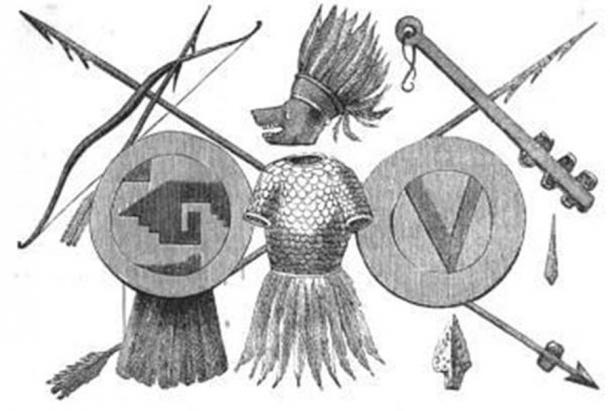
Aztec warrior dress and Aztec weapons. (Brantz Mayer / Public domain )
Bow and Arrow
Another pernicious long-ranged weapon the Aztecs employed was the classic bow and arrow. The Aztec version was usually around 1.5 meters (4.9 feet) long and had bowstrings made out of strong natural materials such as animal sinew and deerskin. Like its atlatl counterpart, the types of projectiles were diverse, including barbed and blunted points fashioned with obsidian, flint, or fish bone . The Spanish noted how the people of Cimatlan were able to shoot an arrow that penetrated the thickest type of double-layered quilted armor.
Similarly, the arrows were also made at the feast of Quecholli, but they could also be re-supplied by other native peoples, who regularly gave the Aztecs bows and arrows as tribute. At Quecholli, the arrows were made out of reeds which were straightened and hardened over fire before being cut at the same point to create a cluster of standardized arrows, which enabled Aztec archers to be extremely accurate by using projectiles of the same dimensions.
Aztec archers usually kept them in quivers which could carry 20 at a time, favoring fire-arrows for the destruction of enemy buildings. Aztec bows had an even greater reach than the atlatl, traveling for 90 to 180 meters once fired. The Aztec Teohuacan were reportedly so skilled that they could launch three arrows at the same time with equal precision.

A deadly Aztec tematlatl sling. ( Deadliest Warrior )
Tematlatl
The final projectile weapon in the Aztec trifecta was the sling or “tematlatl,” which was used to fling stones at opponents. Like Aztec arrows, the stones were also standardized and were molded by Aztec craftsman into a rounded shape to make slingers ruinously precise. They had the biggest scope, as the spherical pellets could be catapulted to 200 meters (656 feet) and at a maximum distance of 400 meters (1,312 feet).
On the battlefield, Aztecs usually used bows and slingers in unison for cripplingly effective ranged attacks. The Spanish were equally as terrified of the dreaded slings , with one conquistador commander Diaz del Castillo remarking how volleys of fired stones were so intense and impactful that even well-armored Spaniards could be injured by their deadly force.
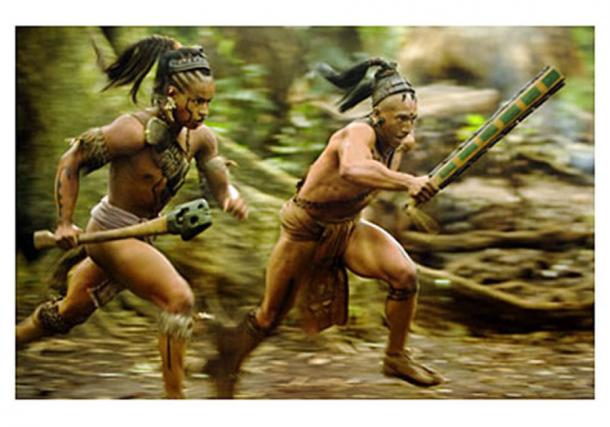
Aztec warriors on the run chasing the enemy through the jungles of Mexico carrying a razor-sharp obsidian bladed macuahuitl broadsword, and a deadly jade-headed club. ( About History )
Thrusting Spears and Clubs: Shock Weapons
Another class of Aztec weapons were the shock weapons, designed to cut, crush, and puncture any unfortunate foes that wandered into their path.
The thrusting spear, or “tepoztopilli,” was commonly equipped by Aztec soldiers. It was longer than the Spanish spear and its stone blades were so sharp that the Aztecs used them to cut their hair. The tepoztopilli was the length of a man at roughly 1.8 meters to 2.2 meters and possessed a triangular or spherical head as well as continuous blades on it sides.
Because of its unusual length and lack of a pointed end, the function of the tepoztopilli was to slash at opponents to cause bleeding damage. At a distance it was extremely effective, but at close quarters the cumbersome article was at a disadvantage, lacking the maneuverability of a shorter weapon. It was another Aztec weapon that could be very hazardous against the conquistadors, with Diaz del Castillo reporting how one pierced his metal armor to an inch of his flesh, only being stopped by an under-padding of cotton.
Another weapon group was the club, which had a variety of specialized and non-specialized versions. The unspecialized club was in widespread use and was often adopted by the lowest ranking Aztec warriors. Some were entirely made out of wood, but others, like the “huitzauhqui,” had stone blades to add cutting damage. For more bludgeoning power, the “cuahhololli” featured a wooden ball at the end for crushing. A more elaborate club was the “macuahuitzoctli” which had a knob of wood sticking out from the side alongside a pointed tip.
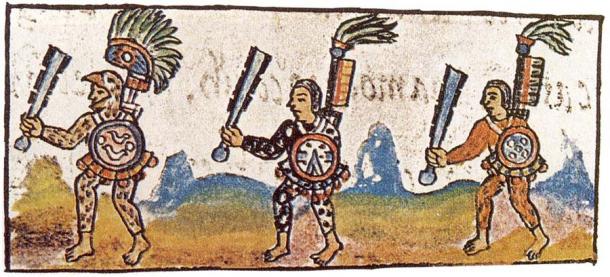
Three Aztec warriors carrying their deadly macuahuitl broadswords. ( Tlacatecco)
“Dreadful Broadswords”: The Aztec Macauahuitl
But perhaps the most fearsome, well-known, and most specialized Aztec instrument of death was the “macauahuitl,” a club weapon favored by elite warriors. It was a wooden bat around 70 centimeters long and contained a set of 6 to 8 serrated obsidian blades on each side, and in the surviving eyewitness accounts was commonly compared to the Spanish two-handed sword because of its wieldy nature. There was also a smaller version called the “macuahuilzoctli,” which possessed 4 blades and measured around 50cm long.
The macauahuitl was famed for its destructive potential which was documented widely by Spanish commentators. Jose de Acosta, remarked how:
“This weapon was so fierce that they claimed with one stroke they could chop off a horse’s head, cutting right through the neck”.
Many Spanish soldiers reportedly witnessed this phenomenon first-hand. Andres de Tapia recounted how:
“As the Spaniards tried to capture one of them to find out where they were from, the Indians with two blows of their swords killed two horses” .
Bernal Diaz, recalling the gallantry of Pedro de Moron, who charged the Aztecs with his horse before falling down and making a quick getaway, commented on the fate of the rider’s horse:
“Then they slashed at his mare, cutting her head at the neck so that it only hung by the skin” .
Francisco de Aguilar, in yet another example, wrote:
“One Indian at a single stroke cut open the whole neck of Cristóbal de Olid’s horse, killing the horse. The Indian on the other side slashed at the second horseman and the blow cut through the horse’s pastern, whereupon this horse also fell dead” .
And finally, an anonymous source recorded how he saw two examples of the macauahuitl’s lethality in one day:
“One day an Indian I saw in combat with a mounted horseman struck the horse in the chest, cutting through to the inside and killing the horse on the spot. On the same day I saw another Indian give a horse a sword thrust in the neck that laid the horse dead at his feet” .
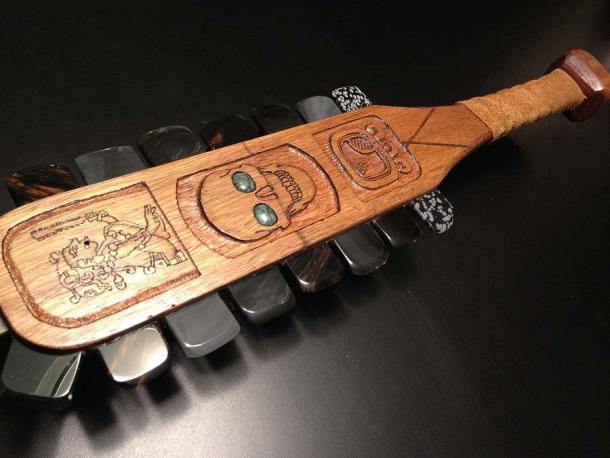
A modern recreation of a ceremonial macuahuitl broadsword, the most famous and deadly of all Aztec weapons. Source: Zuchinni one / CC BY-SA 3.0
Hernán Cortés noted how instances like this would often have a demoralizing effect on the Spanish troops:
“When they killed the mare with a single sword-stroke we were defeated and lost” .
It wasn’t just horses that were divided in two, as some reported that the same fate could also befall a man. Francisco Hernandez de Cordova chronicled how the macauahuitl could:
“… sometimes divide a man in two parts with one single chop, provided this is the first, since all others are useless, such is the sharpness of this weapon and its fragility” .
Among the Spanish, the Aztec macauahuitls were renowned for their ability to decapitate horses and men easily, with conquistador Bernal Diaz characterizing them as “their dreadful broadswords” . Yet some modern scholars have argued that the sources over-exaggerated this point, and, using modern re-creations, have attempted to test this hypothesis.
One such experiment was performed by Aztec academic Marco Obregón, who crafted a macauahuitl to test on the leg joint of a pig carcass in order to determine how much injury it caused and its breaking strength. On the first attack he was able to split open the tissue but, in contrast to the Spanish accounts, he wasn’t able to reach the bone, meaning a clean-cut with one stroke was impossible. On the second attack the obsidian blade was broken. He noted that the muscle and a little bone were penetrated, and most interestingly how micro-flakes of obsidian became lodged into the wound.
It was evident that although it was impossible for the macauahuitl to completely amputate, the limb had been maimed considerably. Such a result meant that the wound would be harder to heal, which led him to the conclusion that the macauahuitl’s main purpose was to disable opponents on the battlefield instead of killing them. Another experiment in 2009 by Rafael Garduño, in which he attempted to cut off the head of a dead horse with the weapon, relayed similar results.
A more sinister interpretation was adopted: It was more likely that the Aztecs used the macauahuitl to maim in order to capture prisoners for the grisly ritual of human sacrifice. It’s well archived that Aztec warriors were ranked in accordance with how many prisoners they could bring back from war.
Captives were usually sacrificed in a variety of brutal ways by Aztec high priests. The unfortunate victims could be decapitated, have their throats cut, be thrown into fire or be tossed from the top of a pole or pyramid. The most common method was to cut the still beating heart out as an offering to the Aztec sun god, Huitzilopochtli. After death, the bodies were cut into various pieces and sometimes ritually eaten. The skulls were cleaned of flesh and deposited on a skull rack to show off to enemies or they were turned into masks and drinking vessels. These ceremonies of death were often performed on maimed prisoners with tools made from obsidian, the same material adorning the macauahuitl that had usually aided in their capture.
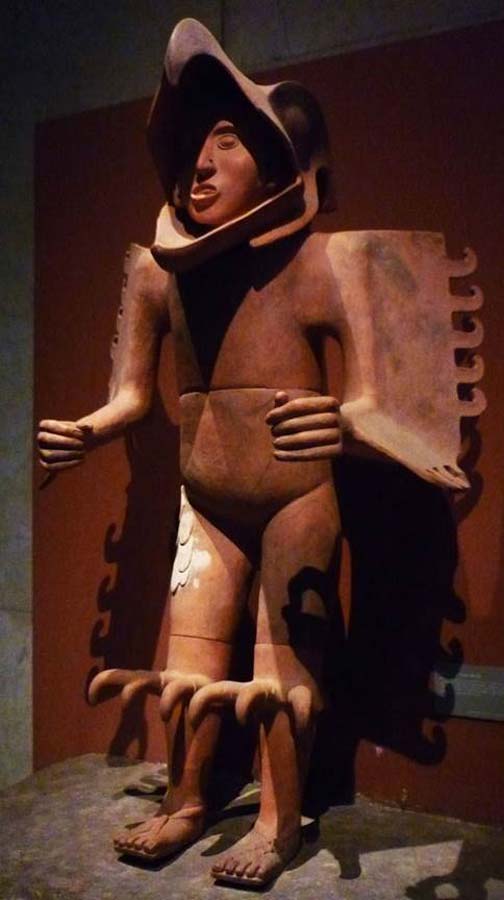
A large ceramic statue of an Aztec eagle warrior exhibited at the Museo Nacional de Antropología e Historia, México. (Maunus / CC BY-SA 3.0 )
Aztec Weapons: Black-Bladed Nightmares
In combat, the Aztec hordes, and their horrifying projectile and shock weapons, were a terrifying prospect to their Spanish adversaries, causing physical as well as psychological damage. Francisco Aguilar recounted one vicious Aztec ambush:
“As soon as this sentry gave the alarm, they all ran out with their weapons to cut us off, following us with great fury, shooting arrows, spears and stones, and wounding us with their swords. Here many Spaniards fell, some dead and some wounded, and others without any injury who fainted away from fright” .
Even after they had been subdued in 1521, the Spanish would still experience occasional glimpses of this unchecked ferocity. During a 1680 revolt against the Spanish governor of New Mexico, the Pueblo people, descendants of the Aztecs, unleashed a furious macauahuitl attack on a statue of the Virgin Mary, according to one Franciscan monk. “with such fury and rage to have shattered the image and destroyed the harmonious beauty of her face” .
In the subsequent years, the Virgin of Macauahuitl would become a famous image. The Virgin, surrounded by macauahuitl wielding Aztec soldiers and images of the devil, would be depicted in a large number of paintings in the 18th century, and would remain a constant reminder of the conquistador experience with the Aztec’s most formidable weapon.
Perhaps it was not by chance that when the Spanish made first contact with the Aztecs in 1519, they were celebrating the festival of Tezcathicopa, the Aztec god most closely linked to obsidian. It was surely an omen of the hellish black blades of the Aztec armory that would spill Spanish blood over the following years of conquest.
Top image: Representational image of an Aztec warrior holding a double-ended spear. Source: Warpedgalerie / Adobe Stock
By Jake Leigh-Howarth
Related posts:
Views: 0
 RSS Feed
RSS Feed
















 April 4th, 2022
April 4th, 2022  Awake Goy
Awake Goy  Posted in
Posted in  Tags:
Tags: 
















